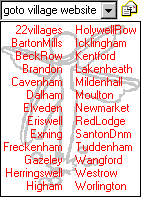













| |
Facts About Moulton
Moulton In The Doomesday Book
After the Norman conquest village life changed little. Moulton whose overlord
before the conquest was Archbishop Stigand, the Saxon, held the manor with 7
caracutes of land It was then passed without much change to Archbishop Lanfranc, who assigned the
manor to provide the Monks with food. In fact the only changes noted in the
Doomesday Book in the 20 years from 1066 to 1086 are that the value of the Manor
dropped from £15.00 to £12.00 and the population changed from:
It was then passed without much change to Archbishop Lanfranc, who assigned the
manor to provide the Monks with food. In fact the only changes noted in the
Doomesday Book in the 20 years from 1066 to 1086 are that the value of the Manor
dropped from £15.00 to £12.00 and the population changed from:
 | 32 Villeins decreased to 22 7 |
 | borders increased to 16 |
 | 6 serfs decreased to 2 |
Population And Housing
Population
|
| 1066 45 persons |
1891 509 persons |
| 1086 40 persons |
1901 527 persons |
| 1327 18 taxpayers paid £3.4s.9d. |
1921 567 persons |
| 1674 41 households (22 houses) |
1931 568 persons |
| 1801 249 persons |
1951 591 persons |
| 1831 366 persons |
1971 1001 persons |
| 1851 486 persons |
1981 1126 persons |
| 1871 512 persons |
1991 1030 persons |
The Manor
Houses
|
| 1674 - 22 |
1901 - 119 |
| 1801 - 36 |
1951 - 188 |
| 1851 - 83 |
1981 - 426 |
| 1871 - 109 |
1999 - 453 |
Of Moulton In 1087
In 1087 the Manor comprised of: Then as now there are 3 ploughs on the
demense and 6 ploughs belonging to the men. And 8 acres of meadow, wood for 20
swine, 2 rounceys, 12 beasts, 40 hogs, 270 sheep and 4 hives of bees. The
estate, then worth 15 Li (pounds), now 12 Li. 1 league long and 7 furlongs
broad, the tax was 13 1/2d. Stigand has soc and sac of all customs
Moulton as a Market Town.
In medieval times villages were called 'Towns'. Moulton was granted a licence
for a market by Edward I, in 1298. The site of the market would have been where
Maltings Close and Lark Hill are now built. This area was called Market field on
the enclosures act map of 1839. The market would have been convenient for the
pack horse route that ran through the village. The market was known to be in use
in 1227/8.
Moulton from 1620 To 1794
Rev Edward Wilson, Rector of Moulton from 1784 to 1823, contributes this
account of the village at the time. " This parish contains about 1600
acres of arable land, chiefly in open fields and lying in small pieces. Course 2
crops and a fallow. About 1000 acres of heath in 8, several sheep walks. Much of
this convertable into good arable. A small quantity of meadow, pasture and
common. Rental about 750 li (pounds) Poor rates about 3/3 sack rent. Houses 37,
inhabitants about 200, wages 14d per day, with beer. Employment of woman and
children, spinning from Norwich ".
Occupations 1797 to 1912
1797 - 63 in agriculture, 13 in retail trade, 1 professional, 7 in labouring,
17 in domestic service, 12 others. 1844 - 2 shoemakers, 2 shopkeepers, 1 tailor,
blacksmiths, carpenter / victualler, maltater, 6 farmers. 1912 - 2 horse
trainers, baker, 2 stud grooms, 2 butchers grocers, butcher, agent to Rt Hon Sir
Ernest Cassel, carrier / thatcher, blacksmiths, publician.
Poor Relief
 | 1776 --- £62.5s.10d, spent on poor relief. |
 | 1803 --- £173.15s.1d, spent on poor relief. |
 | 1818 --- £129.14s.0d, spent on poor relief. |
 | 1830 --- £313.7s.0d, spent on poor relief. |
 | 1832 --- £326.18s.0d, spent on poor relief. |
 | 1834 --- £194.10s.0d, spent on poor relief. |
Births And Deaths 1620 To 1794
In the 20 years ending with: 1620, 132 births, 128 burials 1700, 113 births,
95 burials 1754, 148 births,155 burials 1794, 147 births106 burials
©2000 John Gunson, Village Recorder
|